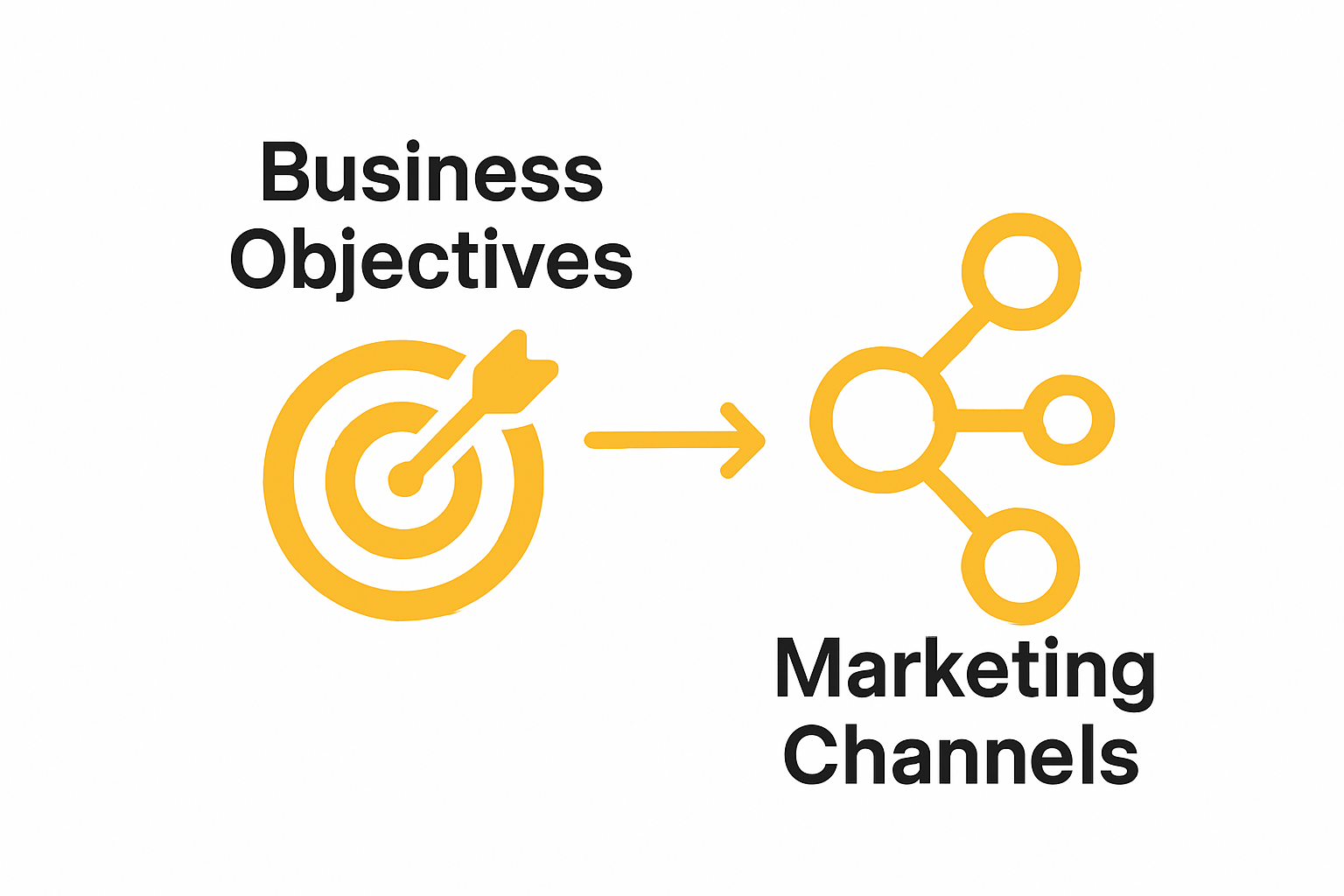Why Digital Marketing for Small Business: Boost Growth Today
- Eddie The Chef

- Sep 9
- 10 min read

Building a digital marketing strategy can feel overwhelming, especially when every expert seems to promise secrets for rapid online growth. Surprisingly, most small Australian businesses skip the most critical part – aligning every digital action with clear business goals. Yet companies that set measurable objectives are up to 376 percent more likely to report successful outcomes. It is not about chasing every shiny platform or trend. It comes down to knowing exactly what you want to achieve and making every move count from day one.
Table of Contents
Quick Summary
Key Point | Explanation |
1. Align Goals with Digital Strategy | Ensure your digital marketing goals directly support your overall business objectives for focused growth. |
2. Create Detailed Customer Personas | Develop in-depth profiles of your target audience to understand their motivations, challenges, and preferences. |
3. Develop a Cohesive Marketing Plan | Map out your digital channels and strategies to connect objectives with practical marketing tactics. |
4. Implement Tailored Digital Channels | Prioritise digital channels that resonate with your audience and consistently engage them with quality content. |
5. Systematically Monitor and Optimize | Regularly review marketing performance metrics and adjust strategies for continuous improvement and investment efficiency. |
Step 1: Evaluate Your Business Goals and Objectives
Establishing a clear digital marketing strategy begins with understanding your specific business objectives. This foundational step transforms random marketing efforts into a targeted, purposeful approach that drives meaningful growth for your small business.
Start by conducting a thorough assessment of your current business landscape. What are your primary revenue goals? Where do you see opportunities for expansion? Many regional Australian businesses make the mistake of approaching digital marketing without a precise roadmap. Your digital strategy must directly align with your core business outcomes.

Begin by mapping out your key performance indicators (KPIs). These might include increasing website traffic, generating more qualified leads, boosting online sales, or improving customer engagement. According to Business Victoria, setting ‘SMART’ goals is crucial - goals that are Specific, Measurable, Achievable, Realistic, and Timely.
Consider creating a simple goal worksheet that breaks down your objectives into actionable targets. For instance, instead of a vague goal like “grow online presence,” specify “increase website conversion rates by 15% within six months” or “generate 50 new qualified leads per month through targeted social media campaigns.”
Your evaluation should also include an honest assessment of your current digital capabilities. What digital channels are you currently using? How effectively are you leveraging them? This audit helps identify gaps and opportunities in your existing marketing approach.
Key verification points to confirm you’ve completed this step include:
A clearly documented list of 3-5 specific, measurable business objectives
Identified digital marketing channels that align with these objectives
Baseline metrics for current performance in each target area
Remember, goal setting is not a one-time exercise but an ongoing process. As your business evolves, your digital marketing objectives will need periodic refinement. Flexibility and consistent review are essential to maintaining a robust and responsive digital strategy.
By meticulously evaluating your business goals, you create a solid foundation for a digital marketing approach that is not just theoretical, but pragmatic and directly tied to your business’s growth ambitions.
Below is a checklist table to help you verify whether you have successfully completed the process of evaluating your business goals and digital marketing alignment, based entirely on the steps outlined above.
Verification Step | Description |
Specific Objectives Documented | 3-5 clear, measurable business objectives are written down |
Channels Aligned With Goals | Selected digital channels directly support each objective |
Baseline Metrics Established | Current performance metrics are recorded for key areas |
Digital Capabilities Audited | Honest assessment of your current digital resources is done |
Ongoing Review Scheduled | Process is in place for periodic goal and strategy updates |
Step 2: Identify Your Target Audience and Market
Successful digital marketing hinges on understanding precisely who your potential customers are and what motivates their purchasing decisions. This step transforms broad marketing approaches into laser-focused strategies that speak directly to the right people at the right time.
Start by developing a comprehensive customer persona that goes beyond basic demographic information. Dig deeper than age and location - explore their motivations, challenges, spending habits, and digital behaviors. For regional Australian businesses, this means understanding the specific needs and preferences of your local market.
According to Business Queensland, market segmentation is crucial for targeted marketing efforts. Begin by analyzing your existing customer base. Review your current client records, purchase histories, and interaction data. What patterns emerge? Which customers provide the most value? What common characteristics do they share?
Create a detailed profile that captures not just who your customers are, but how they think and what problems they need solved. Consider conducting informal surveys or interviews with your best clients to gain deeper insights. Ask about their preferences, pain points, and what they value most in a product or service.
Technology can be a powerful ally in this process. Utilize tools like Google Analytics, social media insights, and customer relationship management (CRM) platforms to gather rich demographic and behavioral data. These resources can reveal surprising insights about your audience’s online interactions, content preferences, and purchasing triggers.
Your audience identification process should result in a clear, actionable understanding of your target market. This means creating 2-3 detailed customer personas that represent your ideal clients. Each persona should include:
Detailed background information
Specific challenges and goals
Preferred communication channels
Typical online and offline behaviors
Remember that target audience identification is not a one-time task. Markets evolve, customer preferences shift, and new opportunities emerge. Plan to revisit and refine your audience understanding regularly.
Verify you’ve completed this step by ensuring you can answer these critical questions: Who are your most valuable customers? What motivates their purchasing decisions? Where do they spend time online? How can your digital marketing strategy uniquely address their needs?
By meticulously identifying your target audience, you transform generic marketing approaches into precision-targeted strategies that resonate deeply with potential customers.
Step 3: Develop a Digital Marketing Strategy Plan
A robust digital marketing strategy transforms scattered efforts into a cohesive, purposeful approach that drives tangible business growth. This step is about creating a comprehensive roadmap that connects your business goals with practical digital marketing tactics.
Strategic planning requires more than good intentions - it demands a structured, methodical approach. Begin by mapping out your digital marketing channels based on the audience insights you’ve already gathered. Not every platform will be right for your business, so focus on channels where your target customers are most active and engaged.
According to Business Victoria, developing a digital strategy involves setting clear, measurable online goals and creating an actionable plan. Start by selecting 3-4 primary digital marketing channels that align with your business objectives. These might include social media marketing, email campaigns, content marketing, or search engine optimization.
For each chosen channel, develop specific tactics and expected outcomes. If you’re targeting Instagram for a local cafe, your strategy might involve creating visually appealing food content, engaging with local foodie communities, and running targeted location-based ads. For a trade business, LinkedIn might offer more strategic networking opportunities.
Budget allocation is critical. Determine how much you can realistically invest in each digital marketing channel. This doesn’t always mean spending more, but spending smarter. Some businesses achieve remarkable results with minimal financial investment by creating high-quality, targeted content.
Consider exploring our guide on understanding digital strategy for more in-depth insights into strategic planning. Your strategy should include:
Specific marketing objectives for each digital channel
Content themes and messaging approaches
Estimated budget and resource allocation
Key performance indicators (KPIs) for measuring success
Develop a timeline that breaks down your strategy into quarterly or monthly milestones. This helps maintain momentum and allows for regular performance reviews and strategy adjustments.
Verify your digital marketing strategy plan by ensuring you can confidently answer: What are your specific digital marketing goals? Which channels will you use? What content will you create? How will you measure success?
Remember, a digital marketing strategy is a living document. Remain flexible and willing to adapt as you gather more data and insights about what works best for your unique business.
Step 4: Implement Core Digital Marketing Channels
Implementing digital marketing channels is where your strategic planning transforms into real-world action. This critical step bridges the gap between theoretical planning and practical execution, turning your carefully crafted strategy into tangible marketing momentum.
Digital channels are not one-size-fits-all - they require tailored approaches that align with your specific business goals and target audience. Start by prioritizing channels that offer the most direct connection to your potential customers. For many regional Australian businesses, this might mean a combination of social media, targeted email marketing, and search engine optimization.
According to Business Australia, establishing digital goals and choosing appropriate online channels is fundamental to success. Begin with platforms where your target audience is most active. A local trade business might find more value in LinkedIn and Facebook, while a boutique cafe might leverage Instagram and local review sites.
Content creation becomes your primary vehicle for engagement. Quality trumps quantity every time. Focus on developing meaningful, valuable content that speaks directly to your audience’s needs and interests. Learn more about content marketing strategies to refine your approach and create more impactful messaging.
Consider your resources carefully. Not every business can manage multiple complex digital channels simultaneously. Start with 2-3 channels where you can consistently produce high-quality content and engage meaningfully. For instance, a small professional service might focus on LinkedIn for professional networking, Google My Business for local visibility, and targeted email newsletters.
Technical setup is crucial. This means:
Creating optimized business profiles on chosen platforms
Developing a consistent brand voice and visual identity
Setting up tracking and analytics tools
Establishing content calendars and posting schedules
Budget allocation matters significantly. Digital marketing doesn’t require massive spending, but it does require strategic investment.

Allocate resources based on potential return on investment, testing and adjusting your approach as you gather performance data.
Verify your channel implementation by ensuring you can confidently answer: Have you established profiles on your chosen platforms? Is your content aligned with your brand and audience expectations? Are you consistently producing and sharing valuable content?
Remember, digital marketing is an ongoing conversation. Stay flexible, monitor your performance, and be prepared to adapt your strategy as you learn more about what resonates with your audience.
The following table summarises core digital marketing channels, their ideal use cases, and which types of businesses or goals they best align with as described in the content.
Channel | Best For | Typical Business / Goal |
Community building, local engagement | Local trades, service businesses | |
Visual content, product showcases | Cafés, boutiques, hospitality | |
Professional networking, B2B leads | Trade, professional services | |
Email Marketing | Retention, nurturing, direct communication | Existing customers, updates/offers |
Google My Business | Local search visibility, reviews | Any business with a shopfront |
SEO (Website) | Organic growth, long-term credibility | Businesses aiming for more website leads |
Content Marketing | Education, authority, trust-building | Services, trade, professional advice |
Step 5: Monitor, Measure, and Optimize Your Efforts
Monitoring and measuring your digital marketing performance transforms guesswork into strategic decision making. This crucial step allows you to understand what’s working, what’s not, and how to continuously improve your marketing efforts for maximum business impact.
Data is your most powerful marketing tool, but only if you know how to interpret and apply it effectively. Begin by setting up comprehensive tracking mechanisms across all your digital marketing channels. Google Analytics provides a free and robust platform for monitoring website performance, while each social media platform offers its own insights dashboard.
According to Business Queensland, developing a digital tracking strategy is essential for understanding customer behavior and improving profitability. Focus on key performance indicators (KPIs) that directly relate to your original business objectives.
Create a monthly reporting ritual where you systematically review your digital marketing metrics. Look beyond surface-level numbers and dig into meaningful insights. For instance, don’t just track website visits, examine engagement rates, time spent on page, and conversion percentages. These deeper metrics reveal how effectively your content resonates with your target audience.
Explore our advanced social media strategy insights to gain more sophisticated understanding of performance tracking. Your monitoring process should include:
Comparing actual performance against original goals
Identifying top-performing content and channels
Analyzing customer interaction patterns
Tracking return on investment for each marketing activity
Optimization is not about dramatic overhauls but consistent, incremental improvements. If a particular social media post generates high engagement, understand why. Was it the timing, the visual style, or the specific message? Use these insights to refine future content strategies.
Budget allocation requires ongoing reassessment. Channels that deliver strong results deserve more investment, while underperforming platforms might need strategic adjustments or replacement. This might mean shifting resources from Facebook to Instagram, or from broad advertising to more targeted campaigns.
Verify your monitoring efforts by ensuring you can confidently answer: Are you tracking meaningful metrics? Do you have a systematic process for reviewing performance? Can you demonstrate specific improvements based on your insights?
Remember, digital marketing is an evolving landscape. What works today might change tomorrow. Stay curious, remain adaptable, and let data guide your strategic decisions.
Ready to Transform Your Small Business Growth with Local Expertise?
Are you tired of scattered digital marketing efforts that lead nowhere? This article showed how setting clear business goals, truly understanding your customer base and building a strategy are the foundation for growth. The real challenge comes when you need to turn that strategic vision into consistent action and measurable results. Many regional businesses face confusion about which channels to prioritise or how to create valuable content that speaks directly to your audience’s needs. You want to see more genuine leads, better online engagement and lasting growth for your small business.

Don’t let uncertainty hold you back from achieving your goals. At Marketing Recipes Australia we specialise in helping local and regional businesses just like yours navigate the entire journey with a holistic approach. From professional video marketing and showcase video creation to tailored content for your audience, our team blends creative storytelling with proven digital strategy. Take the next step and see how we can help you build customer trust and stand out in your market. Visit Marketing Recipes Australia now to start boosting your growth or explore our comprehensive digital strategy insights for more ways to increase your results.
Frequently Asked Questions
What is digital marketing and why is it important for small businesses?
Digital marketing encompasses all online marketing efforts, including social media, email, content marketing, and SEO. For small businesses, it is crucial as it helps increase visibility, reach targeted audiences, and drive sales in a cost-effective way.
How can I define my business goals for digital marketing?
To define your business goals for digital marketing, start by assessing your revenue objectives, identifying opportunities for growth, and establishing specific, measurable, achievable, realistic, and timely (SMART) goals. This ensures your marketing strategy is aligned with your overall business ambitions.
How do I identify my target audience for digital marketing?
Identify your target audience by creating detailed customer personas that include demographic information, motivations, challenges, and digital behaviors. Analyze your existing customer data and consider using surveys or insights from tools like Google Analytics to refine your understanding.
What are some core digital marketing channels I should focus on?
Key digital marketing channels include social media, email marketing, content marketing, and search engine optimization (SEO). Choose the channels based on where your target audience is most active and which align with your business objectives.
Recommended
Comments